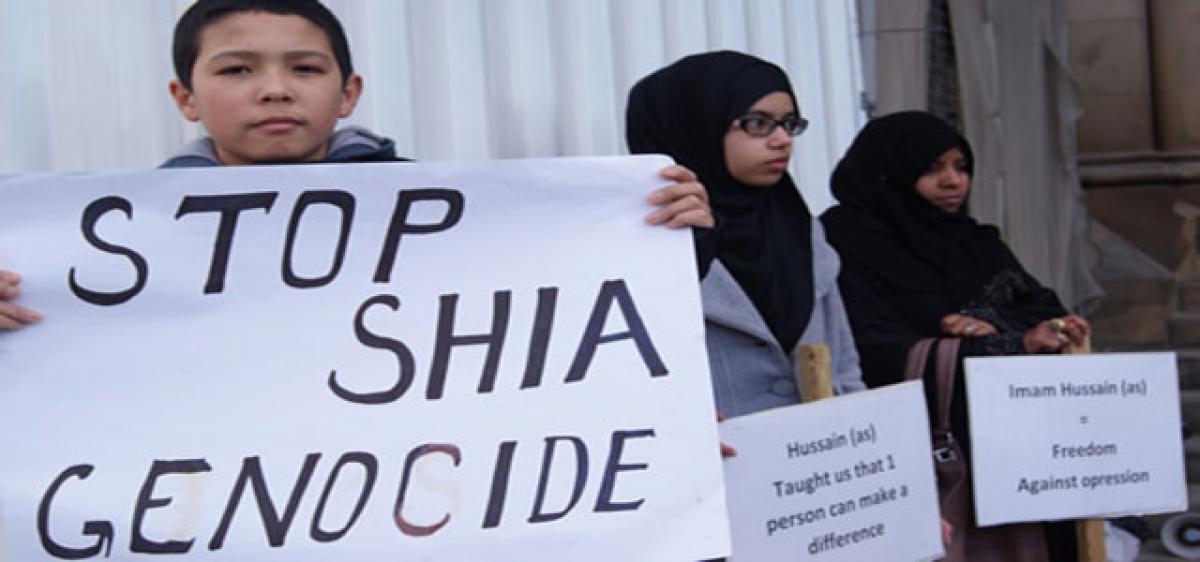Live
- National Conference holds upper hand in J&K alliance as Congress performance below par
- BJP won nearly 2/3 seats it contested in J&K: Assam CM
- Shanghai Masters: Djokovic remains on course for100th tour-level title with win over Cobolli
- PM Modi compliments NC for its victory in J&K polls
- Fan murder case: Hearing on Kannada superstar Darshan's bail plea adjourned to Oct 9
- Kolkata CBI court denies bail to Kuntal Ghosh in teacher recruitment scam
- Congress did Haryana Exit Poll scam: Assam minister mocks Oppn
- Stop Naga human remains auction in UK: Nagaland CM urges EAM Jaishankar
- National Tennis C'ship: Vinayagamurthy stuns Sangram; Samarth keeps on winning in Fenesta Open
- 'Big achievement for AAP': Gopal Rai on AAP's maiden victory in J&K's Doda
Just In

On October 29, 2016, at least five Shia persons were killed and many injured in a gun-and-bomb attack outside a Majlis in the Nazimabad area of Karachi, the provincial capital of Sindh, in Pakistan, where people had gathered for a religious meeting.
On October 29, 2016, at least five Shia persons were killed and many injured in a gun-and-bomb attack outside a Majlis in the Nazimabad area of Karachi, the provincial capital of Sindh, in Pakistan, where people had gathered for a religious meeting.
According to police officials: "Four men wearing helmets and riding on motorcycles came to the house where the religious gathering was taking place in the month of Muharram and they opened indiscriminate firing on the people standing at the gate."
The Lashkar-e-Jhangvi (LeJ) claimed responsibility for the attack. The Sunni supremacist and jihadist militant organisation, whose roots are in the heartland of Punjab province, has a history of carrying out sectarian attacks across Pakistan, particularly against Shia Muslims.
According to data compiled by the South Asia Terrorism Portal (SATP), a total of 2,575 Shias have been killed in Pakistan in 454 targeted attacks since 2001. The rise in the killings of Shias is a manifestation of perpetual anarchy that has gripped Pakistan, the "Land of the Pure", with no hope of refuge for the targeted community. The Shias of Pakistan remain the worst hit.
Militant outfits like LeJ and its extremist allies such as the Tehrik-i-Taliban Pakistan (TTP) alternatively referred to as the Pakistani Taliban along with subtle state support and ideological backing from religious elites, together form the militant troika that has encouraged and thereby sustained the massacre of the Shias. As a consequence, Pakistani society has been poisoned beyond repair.
The historicity of sectarian dissension goes back to the period after Prophet Muhammad's demise in 632 AD when his followers split into supporters of Ali (Shias) and those supporting the companions of Prophet (Sunnis). This broad division between the Shias and the Sunnis has, over a period of 1,400 years, been thoroughly exploited by the power seekers both within and without.
According to the Central Intelligence Agency's (CIA) World Factbook, Shias constitute nearly 10-15 per cent of the population of Pakistan, and are spread across the country. The highest concentration is found in the Gilgit Baltistan Province, where they constitute a majority. The Kurram Agency of the Federally Administered Tribal Areas (FATA) is a Shia stronghold in the tribal belt.
Similarly, all urban capitals, namely, Lahore (Punjab Province), Karachi (Sindh Province), Peshawar (Khyber Pakhtunkhwa Province) and Quetta (Balochistan Province) have sizeable Shia populations. Sunni militant groups, backed by the authorities at the helm, have sustained a violent campaign against Shia Muslims, particularly since the time of former dictator General Zia-ul-Haq.
Prominent anti-Shia groups include the LeJ, the Ahl-e-Sunnat Wal Jama'at (ASWJ), earlier known as Sipah-e-Sahaba Pakistan (SSP), and the TTP. Despite a government ban on these terrorist organisations, they operate freely and brazenly. Sunni extremist formations have propagated their violent ideologies with impunity and in the most open manner possible.
In June 2011, LeJ distributed pamphlets calling Shias wajib-ul-qatl (obligatory to be killed). "All Shias are wajib-ul-qatl. We will rid Pakistan of the unclean race. The real meaning of Pakistan is pure land and Shias have no right to live here. We have the fatwa (religious edict) and signatures of the Ulema (religious scholars) in which the Shias have been declared kaafir (infidel) ... Our mission is the abolition of this impure sect, the Shias and the Shia-Hazaras, from every city, every village, every nook and corner of Pakistan..."
Conspicuously, the state's inaction in mounting effective resistance against the militants is suggestive of collusion and collaboration, each serving the interest of the other. Pakistan has become the operational base for various sectarian militant outfits. The killing of Shias is a manifestation of the existence of an embedded militant troika where three crucial players religious heads, militant operators and the state work in tandem in massacring the community.
By Dr Anurag Tripathi

© 2024 Hyderabad Media House Limited/The Hans India. All rights reserved. Powered by hocalwire.com







